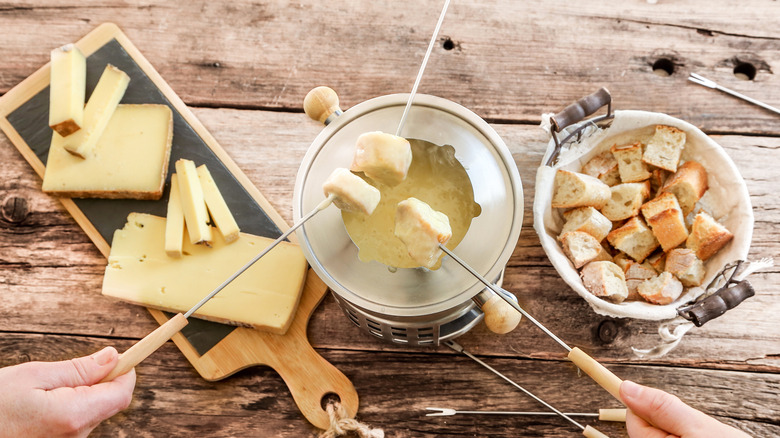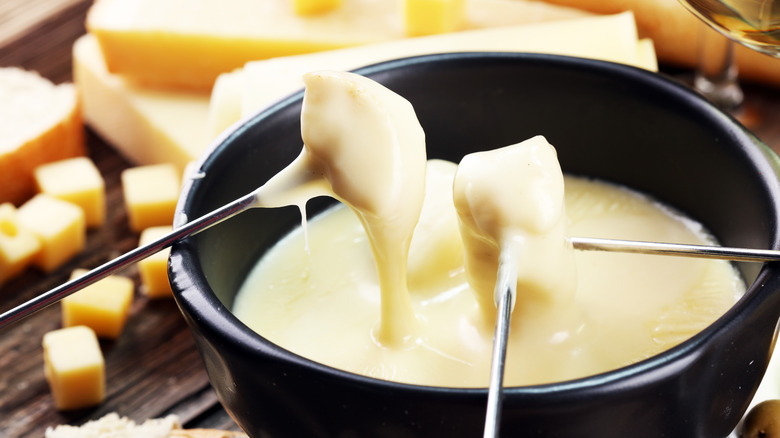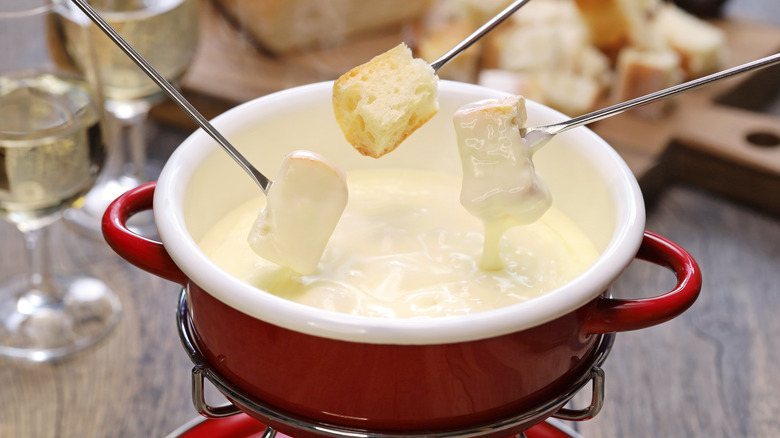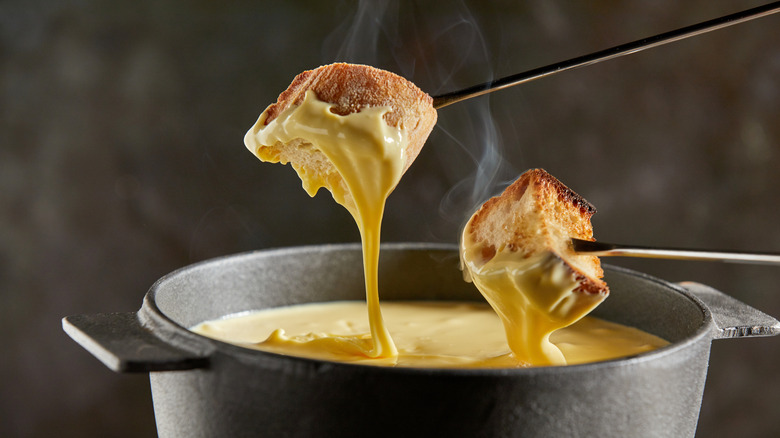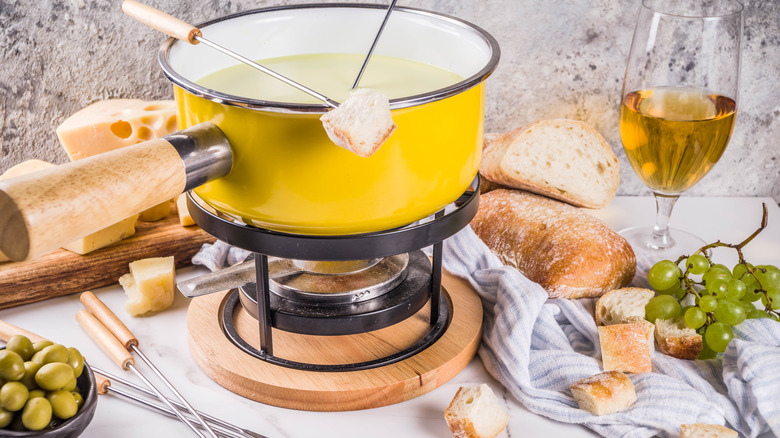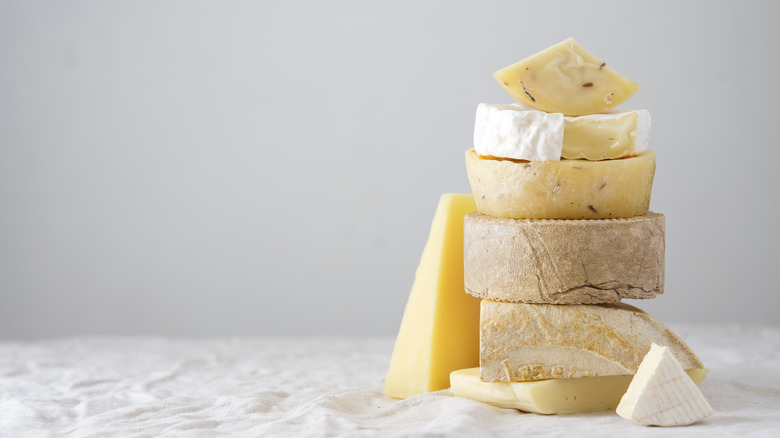What Is Fondue And How Do You Eat It?
Every country has recipes that double as cultural standouts. Consider poutine, an iconic Canadian dish of gravy, fries, and cheese curds, or the saffron-infused Spanish paella (Travel Channel). No one can deny that Switzerland produces quality, handcrafted chocolates, but a second dish comes to mind. The country's other culinary claim to fame, fondue, seems uncomplicated. Dunking pieces of bread into a vat of melted cheese seems like a casual meal, but don't mistake fondue as a simple upgrade from movie theater nachos or pretzel bites. This meal with a long history can please anyone and has ingrained itself into local traditions thanks to its amazing flavor and fun preparation.
After a long day on the slopes, nothing hits the spot like gathering around a pot of bubbling cheese with your friends and family. While this meal looks simple, there's much more to the creation, serving, and tasting of fondue than meets the eye.
What is fondue?
In its most basic form, the term fondue constitutes a pot of bubbling, melted cheese, often soaked up by pieces of cubed bread, fruits, or veggies (via Cheeses from Switzerland). Though you can often find Emmental, or what is popularly recognized as Swiss cheese, in a melting pot, generally Gruyère – a rich, creamy, nutty cheese from the town of the same name — is melted for fondue, mixed with white wine or water, garlic and spices. The mild flavor makes it versatile for pairing well with your dipping sides of choice. Also popular are blends of cheeses, like Fondue moitié-moitié, or half-and-half, which blends Gruyère with Vacherin fribourgeois — another rich melting cheese, similar in taste to the Italian fontina (via Hello Switzerland).
Variations of the Swiss cuisine exist, too, like goat cheese or champagne fondue. Then there are recipes expanding beyond cheese, like tomato fondue that often accompanies boiled potatoes, or mushroom fondue. Outside of Switzerland, even more takes on the traditional meal, like fondue savoyarde in France, fonduta Piemontese in Italy, and American chocolate fondue grace tables.
Where did fondue originate?
The origins of fondue are a little murky. Some reference the mixture: goat cheese, wine, and flour mentioned in Homer's "Iliad," dating back to the years between 800 and 725 B.C., as the recipe's conception. According to BBC, a 17th-century Swiss cookbook, "Kochbuch der Anna Margaretha Gessner," also gave a nod to the cheesy mixture. Yet, scholars often trace the modern version of cheese and wine all the way back to the French Rhône-Alpes region near the Geneva border in the 1800s, long before the food found its way to trendy restaurants like The Melting Pot.
Before it was declared the country's national dish in 1930, fondue was a recipe used out of necessity by peasants in the Swiss Alps. Taste Atlas shares that herders and alpine locals often relied on leftover cheese and stale bread to get them through the months of cold, harsh weather, when produce was inaccessible.
How is fondue made?
A proper ensemble of equipment is needed to reach fondue perfection. First, you need the caquelon, or the melting pot itself. Traditionally, they're made from cast iron, enameled steel, or ceramics, per Cheeses from Switzerland. You'll need a caquelon that can hold at least two liters to serve six or more guests, and make sure to check the handling and care guide, as most caquelons can't go through the dishwasher.
Next, you need a réchaud stove. This mini, portable appliance allows fondue to be taken anywhere outside of your kitchen limits. Models vary — some require fuel or batteries, but classic rèchauds use methylated spirits behind a tiny open flame to keep fondue warm.
For the ingredients, you need grated cheese, garlic, Swiss white wine, some lemon juice, and a few tablespoons of cornflour to bind the mixture to make authentic fondue. Throw in a splash of cherry brandy and shallots or season to taste with pepper, nutmeg, and whatever else you're in the mood for, then blend these items together to a slight bubble over low heat, and you're ready to eat. If your cheese sauce gets too thick, add some wine, turn up the heat, and stir. If the cheese mixture gets too runny, add in some more corn starch. In situations where you don't want to accidentally consume alcohol, feel free to swap out the wine and brandy for apple juice.
How to eat fondue
When it comes to enjoying bona fide fondue, there are technicalities when it comes to ingredients and preparation. The bread often used for fondue is mi-blanc, or oval-shaped, white bread with a thin crust. It's best served a day old to give it some sturdiness and prevents it from getting lost in the fondue pot. Use long fondue forks to dip bread or any other sides, but make sure to use them only for dipping, not eating. The proper dipping method requires you to use the forks to dip the bread into the pot, then discard the dipped item onto your plate to eat with a separate fork and knife. While considered proper, not many people follow this rule (via Hello Switzerland).
Some rules are more common sense — don't double-dip your bread, don't dip if someone else's fork is in the pot, and don't partake if you don't feel well. Other Swiss fondue traditions include le coup du milieu, a drink of brandy when you hit the halfway mark of all the cheese in the caquelon, and la religieuse, or sharing the crust of burnt, crisp cheese at the bottom of the fondue pot with those you're enjoying the meal with.
Nutritional information about fondue
While fondue proves delicious, don't expect your fondue meal to be light in calories. The actual calorie count will vary depending on what types of cheese, wine, bread, and other sides you use, but about one cup of cheese fondue pack in almost 500 calories, according to Eat This Much. Adding white bread raises the calorie and carbohydrate count while dipping cured meats increases the amount of protein with your meal.
If you want to lower your sodium intake, cheese fondue likely isn't the best choice for dinner. According to Nutritionix, one cup of fondue measures out around 807 milligrams of sodium. The same cup of cheese fondue provides 21% of your daily value of Vitamin A, and a mere 3% of the recommended daily intake of iron. Fondue does provide loads of calcium, with a single cup offering 115% of your daily serving of the mineral.
Fondue might not be the best option for those on meal plans, but there are ways to lower the calorie and fat content of the ingredients you use — it just doesn't follow the traditional Swiss recipe. Opt for pecorino, light brie, and low-fat Jarlsberg cheese can take the place of rich Gruyère, and consider using dry, low-calorie champagne for the wine option (via The Wichita Eagle).
